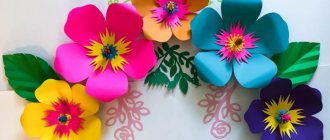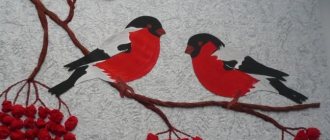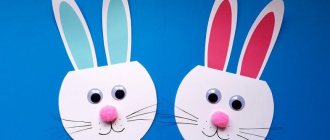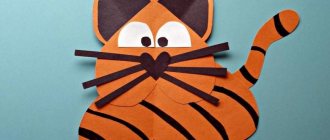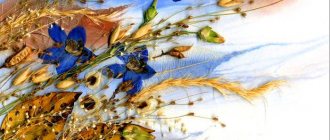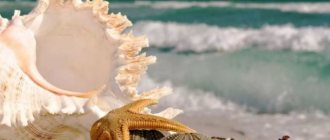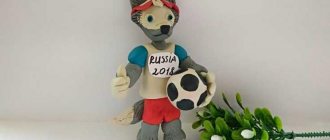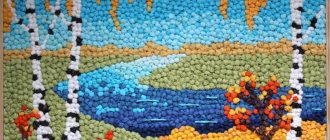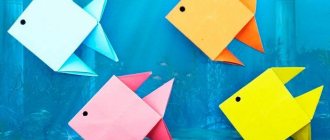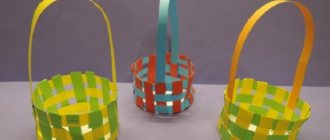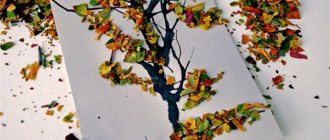Children of any age can make applique animals. As a rule, children are very interested in such crafts. You just need to choose the right level of difficulty for each age group of children.
To make all applications you will need the following tools and materials:
- stationery glue or glue stick,
- simple pencil,
- ruler,
- scissors,
- cardboard,
- colored paper of various colors,
- multi-colored felt-tip pens or markers
- ready-made paper templates.
Animal applications for children under 3 years old
For very young children, flat animal applications made from geometric shapes - circles, ovals, triangles, rectangles and squares - are suitable. At the same time, this will allow you to get acquainted with these figures in a playful way and learn how to work with them.
Before working with your child, all elements should already be cut out of paper. It is advisable to show the child a drawing of the finished application and, naming the figures on it, invite him to choose similar figures from several different ones. Draw the child's attention to the importance of color.
Next, tell us in what order you need to assemble the applique and show how to apply the glue correctly. You need to start working with animals that are well known to the child, for example, a dog, a cat or a bird.
In the future, it will be possible to offer the creation of images of other domestic and then wild animals. It is important to focus the baby’s attention on the distinctive features of each animal that make it recognizable.
For younger children, the application should consist of large parts and a small number of elements, so that children do not lose interest in the process.
On the topic: methodological developments, presentations and notes
Teach children to create images of objects by crumpling paper, to correctly compose a round image by successively reducing the shape, placing the image in the center of the sheet.
“NIGHT OUTSIDE THE WINDOW” GOALS AND OBJECTIVES: Continue to teach children to carefully stick the image onto a given plane of the sheet (only on the black sky), placing it over the entire plane. Perfection
MBDOU "CRR - kindergarten "Bell" Summary of a lesson on application in the second junior group "Winnie the Pooh". Topic: “House for the Bug.” Educator
Summary of a lesson on appliqué in the second junior group “The chicken went out for a walk.”
This material forms children’s understanding of transport, its classification, and components.
This summary will help introduce children to the shape of a square and teach them how to compare it with a circle.
Consolidating children's knowledge about animals of the North, about their life in nature. Strengthen the ability to carefully perform appliqué.
Source
Paper animal applications step by step
Children in the middle group can be asked to make an applique of the following domestic and wild animals from scratch:
cat
You can offer to make a cat for the youngest children who are just learning to work with scissors.
First, you need to invite the child to choose the color of the future cat and draw on paper of that color a head - a circle, a body - an oval, ears - triangles, paws - elongated rectangles and a tail - an arc.
Then you need to cut them out and assemble them into a finished animal on a sheet of thick paper or cardboard. In conclusion, draw the muzzle.
Piglet
The piglet is made in the same way as a cat. But for recognition, in addition to the pink color, the body needs to be made thicker and more voluminous, and the legs thinner and smaller. They should end in hooves.
You need to glue a white or red circle - a snout - onto the muzzle, and make the tail curl. Older children can make this voluminous craft from rolled paper.
Dog
For small children, it is better to print out a dog template. The animal on it can be of any breed, in full face or profile, or just a close-up portrait. You just need to follow the rule - the smaller the child, the larger the parts.
The template must be cut into separate parts, traced around them like patterns on paper of the desired color and cut out. Then glue the cut out parts onto a sheet of thick paper or cardboard and draw a face, eyes and mustache.
Cow
The youngest children need to be given ready-made parts for gluing. Older children can draw them according to a template and cut them out themselves, as well as make a composition of several cows grazing in a meadow.
We need to draw children's attention to the fact that one of the most recognizable features of a cow is its large contrasting spots.
Lion cub
For the lion cub you will need yellow and orange paper, plastic eyes and a template. You need to trace according to the template on yellow paper and cut everything out according to the template. Then cut a wide strip from the orange one and cut it crosswise into narrow “noodles”, not cutting through the strip all the way.
Next, take a circle of yellow paper that will serve as the head, and stick a cut strip of “noodles” onto it around the perimeter on the back side. Glue the lion cub's tail to a piece of cardboard first, then the body, front paws and finally the head. Glue on the eyes, draw a muzzle and mustache.
Penguin
The little penguin is suitable for children of the middle group. To create it you will need black, white and orange paper. From black you need to cut out a large oval for the body and elongated triangles for the wings.
From white - a small oval for the chest and a circle for the head. The orange one has a triangular beak and flippers. All parts must be well glued to the base.
Dragon
To make a dragon you will need green and some yellow paper. On the red one you need to draw 4 large circles using a template and cut them out. Then fold each circle in half and cut. And fold each half in half, the colored side inward.
Glue together quartered circles in pairs to form a book. Glue it with the “cover” pages to a sheet of paper. The result is the body of a dragon. Using the template, draw and cut out a head with a neck and a tail from red paper. Glue them on opposite sides of the body.
Using the neck template, draw and cut out a semicircular strip from yellow paper. To turn it into the comb of our dragon, cut out the cloves in its upper part. Cut out several yellow circles.
Glue the comb to the neck, and the circles all over the dragon's body, including the neck and tail. Draw the eyes and teeth of the dragon.
Outline for the application “Wild Animals”
Semenova Tatyana Raisovna
Outline for the application “Wild Animals”
Topic: Wild animals .
– expand children’s knowledge about wild animals
– strengthen children’s ability to work with templates and trace along the contour.
– improve the ability to work with scissors.
– Continue to develop figurative, auditory, visual perception, thinking, attention and speech.
– develop gross and fine motor skills of the hands.
– cultivate the ability to plan one’s activities , accuracy in performing work, and perseverance.
– instill a friendly attitude towards the natural environment.
– develop the ability to work in a team, communication skills.
– review of the album “ Wild Animals ”
, conversation about
wild animals , reading fiction.
– showing children a shadow theater to familiarize themselves with the silhouettes of animals .
– creation of the composition “autumn forest”
.
Materials: Composition “Autumn Forest”
, colored woolen threads, scissors, glue, glue brushes, simple pencils, animal templates, napkins.
The group is decorated in an autumn forest.
1. Organizational moment
Guys, I suggest you go to the kingdom of wild animals . If we want to go to the kingdom, then we need transport, not simple, but magical. Let's go on a fabulous transport, let these be our chairs. We will say the magic words and our chairs will fly to the kingdom of wild animals .
1.2.3 - my chair fly! (children close their eyes and imitate moving their arms to the sides and land in the forest)
Here we are in the kingdom of wild animals . Admire the beauty of autumn trees, colorful leaves. We really entered the kingdom of wild animals .
1). We saw the tracks. Q: Guys, let's follow the tracks. Whose traces do you think these could be?
Bear. (bear growl)
What is that sound? Who makes this sound?
The teacher displays a picture of a bear and the children talk about the bear.
– What do you know about the bear? (One child tells and hangs it on a magnetic board)
.
2) We saw footprints again. Q: Whose footprints are these?
These are fox tracks. (fox cry)
Who makes this sound?
This is the sound made by a fox.
The teacher displays a picture of a fox and the children talk about the fox and hang it on a magnetic board).
3) We saw the tracks of a hare. Q: Whose tracks are these?
These are hare tracks because...
The teacher displays a picture of a hare and the children talk about the hare and hang it on a magnetic board.
4) whose traces are these?
These are the tracks of a wolf. (children guess whose howl)
The teacher displays a picture of a wolf and the children talk about it and hang it on the board)
5). Let's go, whose tracks are these?
These are squirrel tracks. (The sound of a squirrel, who makes this sound?
this sound is made by a squirrel. (children talk about the squirrel and post it on the board)
Guys, what animals did we meet ?
bear, wolf, fox, hare, squirrel - wild animals .
Q: Guys, what time of year is coming soon?
Winter. yes, winter. I suggest you dress wild animals in warm fur coats so that they do not freeze in winter.
Now let's get to work. Here on my table are colored threads and patterns of wild animals , choose which animal you wanted to dress . Have you thought about what color of thread you chose and why?
I chose the orange color of the threads because the fox has an orange coat...
In the middle of the lesson there is a warm-up game “To the Watering Place”
One day, along a forest path, animals walked to a watering hole (children calmly walk in a circle)
A little fox was sneaking behind the mother fox (sneaking on tiptoes)
A bear cub walked behind the mother bear (they waddle)
The baby squirrels jumped after the mother squirrel (they jump in a squat position)
Behind the mother hare are the slanting hares (jumping on straightened legs)
The she-wolf led the wolf cubs (walking on all fours)
All mothers and children want to get drunk (face in a circle, make a tongue movement and lap)
.
Who dressed the animal in a fur coat , we move it into the forest. (autumn forest leaf prepared in advance)
Where would you like to place your animal ?
Look what a beautiful picture of the forest it turned out to be!
Guys, we need to go back to kindergarten. We sat down on the chairs and said the magic words: 1.2.3 - my chair fly (close your eyes)
So we flew back to our kindergarten.
Children's master class on volumetric applique from natural material “Wild Animals” Master class on volumetric applique “Wild Animals” from natural material – fallen autumn leaves – was carried out by preparatory children.
Lesson summary “Wild animals of our area” Purpose: to familiarize children with the changes that have occurred in the life of forest animals with the arrival of winter. Objectives: To clarify children’s knowledge of where they spend the winter.
Summary of the lesson “Wild Animals” in the middle group Goal: to systematize and clarify children’s knowledge about wild animals. Objectives: Educational: learn to pronounce certain sounds, guess.
Animal appliques made from accordion paper
It’s just as easy to make animal appliqués from accordion paper. First, children need to be explained how to fold an accordion out of paper. This application will be interesting in the middle group and is suitable for the theme of domestic or wild animals. There are several ways to make such crafts:
- An accordion fan. If you glue an accordion on one side, you get a fan. The easiest way to make a hedgehog is based on it. The paper fan will represent a body with needles. To its base you need to glue a semi-oval made of paper with a drawn muzzle and two legs to it from below.
- Accordion circle. By gluing two fans together, we get a circle. It can act as a body for a pig, a mane for a lion or a face for appliqué of any other animals. The missing body parts need to be glued to it.
- Straight accordion. It will serve as a body to which you can glue the head, legs and tail - you will get an applique of any wild or domestic animals. You just need to choose the desired color of paper and add a face to the finished application.
Volumetric animal applications
There are several ways to make a three-dimensional paper applique:
- Strip applique. To use this method, you need to glue the animal’s body together from narrow strips, like a flashlight. And glue a paper head, legs and tail to it. You can make a whole exhibition of works on such an application in the senior group - for example, on the topic “Animals of the North”. You can invite children to make one of the following animals: deer, wolf, polar bear or owl.
- Cone applique. Cone-based applications are perfect for developing children's imagination. For example, for children in the preparatory group, you can suggest a theme for the application “Animals of hot countries.” Children can make a tiger, lion, giraffe, elephant or crocodile. The cone can act as a head, torso, or any other part of the body. For younger children, the cutting of the cone should already be ready, and a sample should be provided for copying.
- Cylinder applique. The scheme is the same as in the previous versions, but this craft is easier to make. Plus, absolutely any animal can be made this way.
Anteater applique
Anteater Facts:
- They are edentulous animals, meaning they have no teeth at all.
- Anteaters use their long tongues to swallow 35,000 ants and termites every day!
- They find food by smell.
- Anteaters live in tropical forests and grasslands of Central and South America.
- They live for about 14 years and are classified as endangered.
Animal leaf appliques
In this type of application, the selection of material is important. It is best to store leaves in the fall - then there is an opportunity to collect material of various shades, especially warm tones. The leaves need to be straightened and placed between the pages of a large format book.
They must remain there until completely dry, otherwise the leaves will curl. It is better to collect leaves together with children, simultaneously explaining to them where each tree is and telling them about them.
Working with leaves is practically no different from working with paper, except that dry leaves are quite fragile and they do not stick well. Application of leaves develops the child's imagination.
He learns about the properties of natural materials and learns to work with them, compares the shape and color of various objects.
Applique Grizzly Bear
Grizzly Bear Facts
- Although grizzly bears are not endangered, an existential threat exists. 1,000 grizzly bears left in the wild .
- Grizzly bears are a North American subspecies of brown bear.
- Grizzly bears are often seen at some of Alaska's best fishing spots, where they feast to accumulate enough body fat to survive the winter.
- During the winter, grizzly bears hibernate. They dig holes on the hillside. Females give birth at this time.
- Grizzly bears are powerful predators, although they eat a wide variety of foods. Nuts, seeds, berries, fish, rodents and moose!
Fabric animal appliques
Fabric appliqués are usually used as decoration for clothing or other textiles. They can be made by older children who are familiar with the technique of sewing by machine or by hand.
The principle of operation is the same as for paper, except that such an applique is sewn on rather than glued, and when working with loose fabrics it is necessary to overcast the edge.
The design is transferred to dark fabrics not with a pencil, but with a piece of soap. You can use contrasting threads to “draw” the face or highlight the outline of the animal. The child will be happy to wear something decorated with his own hands.
Craft Warthog
Facts about warthogs:
- The "spikes" and bumps on a warthog's face... those are warts!
- They are from the same family as the cute domestic pigs, although they look different.
- They have 4 tusks (although our template only shows two).
- They eat grass and plants and dig up roots and bulbs.
- They live for about 15 years.
- Warthogs can go for long periods without drinking water.
Applications of animals from cotton wool
Cotton wool is a good material for applique, perfectly conveying animal hair. To work with it, children need to draw the outline of an animal.
It needs to be filled with cotton wool close to the texture of the fur of a particular animal: for a sheep - with lumps, for a dog - with narrow hanging strips, etc. If desired, this “wool” can be painted.
It is quite possible to simply cut out some of the elements from paper and stick them on.
Animal applications using quilling technique
Quilling is an application of increased complexity. The work consists of gluing narrow strips of paper, usually folded in the form of spirals, onto cardboard.
First, the outline of the animal is glued, and then it is filled from the inside with curls of the desired shade. This technique is good because it successfully imitates the texture of animal fur or bird feathers.
All children, without exception, love creativity. Therefore, appliqué is one of the most interesting hobbies. Children work with her with great pleasure both in kindergarten and at home. Not only is it a wonderful leisure activity for a child, but it also develops his imagination.
Gorilla cutout
Gorilla Facts:
- Gorillas are classified as endangered.
- There are only 700 mountain gorillas left on Earth.
- Although their numbers are slowly increasing due to conservation efforts, habitat loss and poaching still pose a major threat to these animals.
- Baby gorillas love to ride on their mother's back.
- Gorillas are herbivores and primarily eat bamboo and other leafy plants.
- Gorillas can live 40-50 years.
- They are very smart!
